Bamboo horse performance once again enjoys galloping appeal, report Yang Feiyue in Beijing and Sun Ruisheng in Taiyuan.
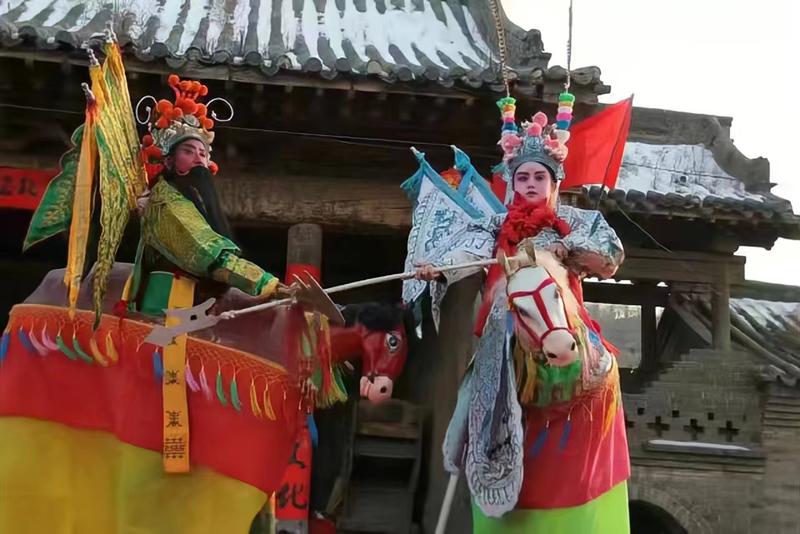 Guo (left) performs with his daughter. (TIAN ZHAOYUN / FOR CHINA DAILY)
Guo (left) performs with his daughter. (TIAN ZHAOYUN / FOR CHINA DAILY)
Back in the Tang Dynasty (618-907), a "bamboo horse" was revealed in the great poet Li Bai's work, The River-Merchant's Wife.
It depicts a wife's memories of her husband as a young boy, who used bamboo stilts to mimic a horse.
Today, an ancient art form featuring the bamboo horse has found a new lease on life in North China's Shanxi province.
The pair of stilts resemble horse legs, and performers look as if they are floating in the air, juggling between keeping balance and delivering the intensity of combat at close quarters.
Chen Liying, a fan of bamboo horse drama
At one performance, fluttering polychromatic flags danced in the wind and lanterns and colored streamers adorned the mountain village of Guojiagou in late July.
Actors were in traditional opera makeup and costumes, ready to get onstage. They adroitly tied nearly 1-meter-long stilts to their legs, with their feet on a small horizontally protruding wooden stick that bore their weight.
After ensuring the stilts were securely fastened, they nimbly sprang up and stepped into an opening in the middle of the bamboo horse prop, before carrying the whole thing up and dashing forward.
For a split second, they looked like some ancient horse-riding generals, brandishing swords for battle.
Applause broke out, as if on cue, from the crowd.
"It was filled with festivity everywhere," says Guo Yonghu, who still fondly reminisces about the grand and joyous scenes from the first local bamboo horse drama festival staged in his rural hometown Guojiagou in late July.
"It was so great to see the type of show make a comeback," says the 60-year-old, who has committed himself to the inheritance and development of bamboo horse performance that originated in Guojiagou in Shouyang county, Shanxi province, over the past decades.
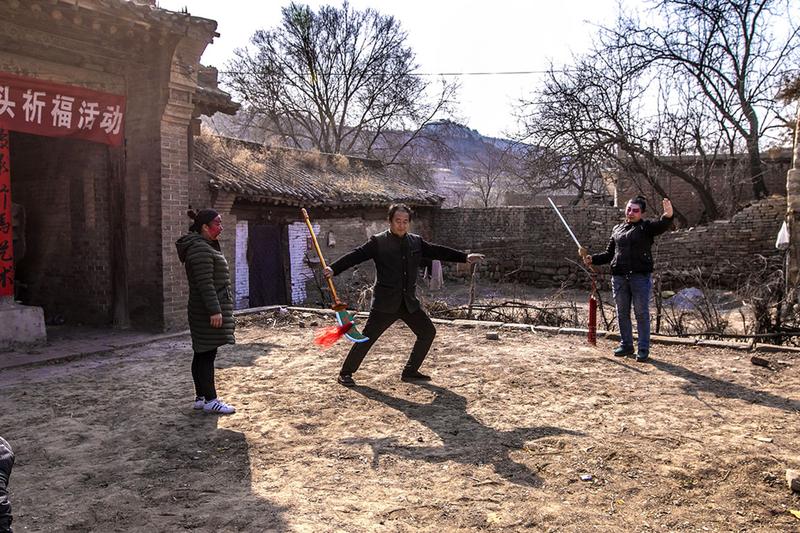 Guo Yonghu (middle) demonstrates bamboo horse moves for two actors. (TIAN ZHAOYUN / FOR CHINA DAILY)
Guo Yonghu (middle) demonstrates bamboo horse moves for two actors. (TIAN ZHAOYUN / FOR CHINA DAILY)
His excitement is evident when he introduces the local art.
The performance is a traditional theatrical dance that uses horse-shaped props and boasts a history of around 700 years.
It integrates folk dance and opera elements and is mostly based on figures from well-known historical dramas.
Under the artists' ingenious maneuvering, the bamboo horses seemed to have a life of their own, turning their heads and thrashing their tails.
"The vivid presentation of those historical figures could bring the audience back to the long journey of the past," Guo says.
He worked as an accountant in Guojiagou after finishing middle school.
Since entering the 21st century, Guo says he has greatly appreciated the increasing emphasis put on the protection of intangible cultural heritage by local authorities.
 A bamboo horse drama artist adjusts the stilts for her student. (TIAN ZHAOYUN / FOR CHINA DAILY)
A bamboo horse drama artist adjusts the stilts for her student. (TIAN ZHAOYUN / FOR CHINA DAILY)
Growing up in a family that has performed the bamboo horse show for five generations, Guo felt obliged to revive the traditional art.
He used his spare time to collect and study everything to do with the history of the bamboo horse show, to get down to its bare essentials and reveal its true essence.
Guo found that the show evolved from ancient exorcising dances featuring exaggerated facial masks, which were discarded during the Qing Dynasty (1644-1911), when the show started to focus on historical figures.
Performers chanted words and folk songs, while wearing their bamboo horse on their stilts to deliver scenes depicting combat.
"Our family is the only one that has carried on the show without stopping," Guo says.
"My father is pushing 80, but he can still get up on stilts and perform."
Inheritance of the bamboo horse drama was arduous.
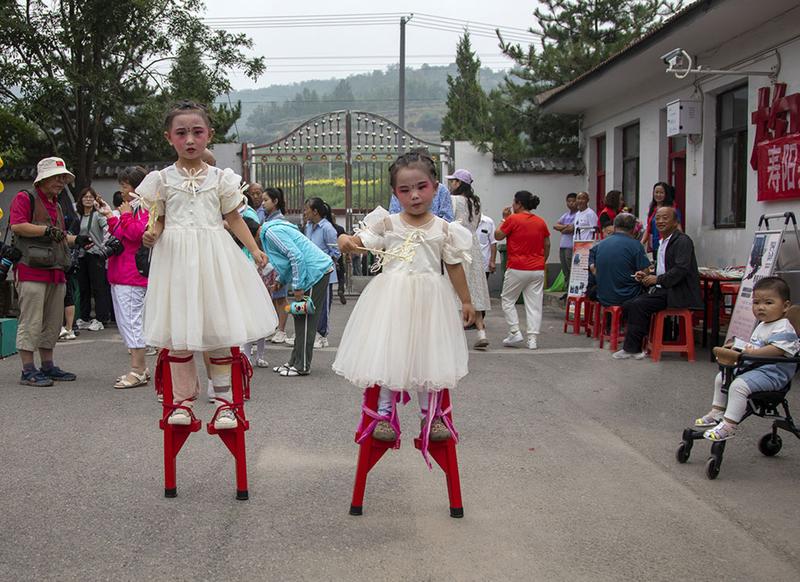 Guo's two grandchildren learn how to keep their balance. (TIAN ZHAOYUN / FOR CHINA DAILY)
Guo's two grandchildren learn how to keep their balance. (TIAN ZHAOYUN / FOR CHINA DAILY)
In the 1930s, the Japanese invaders occupied Shouyang and forbade locals to host folk gatherings. The bamboo horse performance was forced to stop.
It wasn't until 1975, when Shouyang county authorities decided to host a gala to celebrate the harvest, that the bamboo horse show got to see the light of the day again.
"There were six bamboo horses at that event, and I was the only performer of my age among older actors, including my father," Guo recalls.
"That was when I got serious about the bamboo horse."
Although Guo had led a team to give performances in various events during the following years, he says he didn't take them as the "authentic" bamboo horse drama.
"We just presented the form of the dances, but without any plot," he says.
As most of Guo's predecessors passed away, few people could put on a real bamboo horse drama.
Guo says it was painful for him to see this precious cultural heritage on the verge of disappearing.
 Guo trains pupils in a local school. (TIAN ZHAOYUN / FOR CHINA DAILY)
Guo trains pupils in a local school. (TIAN ZHAOYUN / FOR CHINA DAILY)
The change came in 2005, when the State Council issued a notice on strengthening the protection of cultural heritage, which renewed Guo's determination to revitalize the historical art.
With nearly all historical performance information missing, Guo spoke to his elders in the village and got five bamboo horse drama scripts based on their memories.
His efforts helped publicize the art form, which was named a provincial intangible cultural heritage in Shanxi in 2008 and was put under protection as a key national cultural ecology project in the province in 2012.
In the winter of 2014, Guo dug into his own pocket and spent more than 100,000 yuan ($14,500) buying props and musical instruments, in an effort to establish a bamboo horse performance troupe.
However, the most difficult part turned out to be finding performers.
"Many villagers had left the village to work in the cities," Guo says.
"Some didn't want to join after finding out it was organized by me, an individual who might not even pay them."
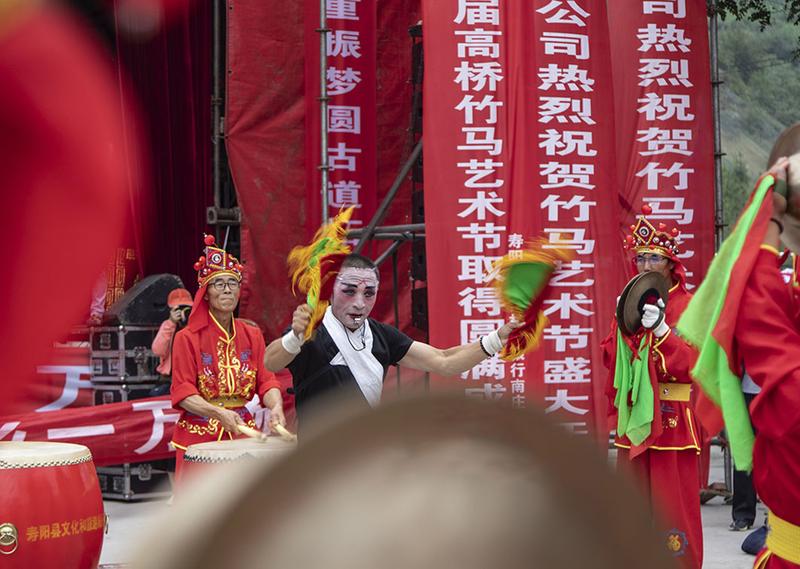 The first bamboo horse drama festival held in Guojiagou in late July. (TIAN ZHAOYUN / FOR CHINA DAILY)
The first bamboo horse drama festival held in Guojiagou in late July. (TIAN ZHAOYUN / FOR CHINA DAILY)
Therefore, Guo started to mobilize people that were close to him, from his daughter to his nephew.
Once he got the ball rolling, more people joined out of curiosity.
Under his training, the troupe went from being unable to carry the props to nimbly pulling stunts on stilts. They immediately packed the crowds in and started to make their presence felt outside the province.
Guo and his troupe have often been invited to give performances at big events, such as local culture and tourism promotions across the country.
They also made a point of collecting folk culture and tales in rural areas. They published their findings and re-creations in the book, Shouyang Bamboo Horse, for the public to better appreciate the drama's charm.
In 2019, Guo was named an inheritor of the provincial cultural heritage in Shanxi, and his performance stood out among other performances nationwide at the Chinese Opera Gala that was staged in Kunshan, Jiangsu province, in 2020.
"It was the first time the Shou-yang bamboo horse drama showed itself on a national stage," says Zhang Changgen, an official from the Shouyang county culture center.
"Everyone had been preparing very hard, striving for perfection," Zhang says.
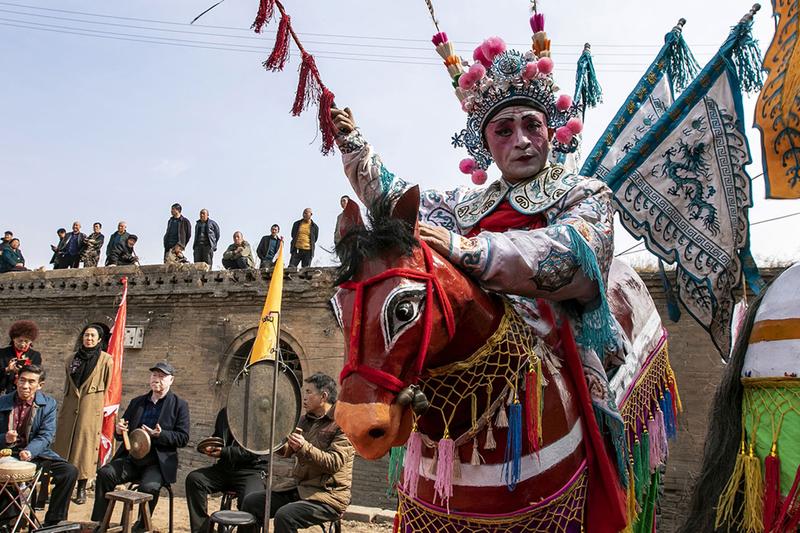 An actor portrays Lyu Bu, a general from the Three Kingdoms (220-280). (TIAN ZHAOYUN / FOR CHINA DAILY)
An actor portrays Lyu Bu, a general from the Three Kingdoms (220-280). (TIAN ZHAOYUN / FOR CHINA DAILY)
Chen Liying has been a big fan of various traditional dramas. She says she is impressed by the presentation of the drama.
"The pair of stilts resemble horse legs, and performers look as if they are floating in the air, juggling between keeping balance and delivering the intensity of combat at close quarters," she says.
Having done so much for his beloved bamboo horse drama, Guo is not resting on his laurels. He has continued to make inroads into local schools to promote the art.
"Intangible cultural heritage is a nonrenewable resource, which contains the wishes and emotions of our ancestors, and their unique ways of thinking and aesthetic habits," he says. "That makes it a living fossil of folk art."
Therefore, he considers it necessary to tell local children about the history of the land and the unique folk art growing on it.
"Because they, and only they, are the real inheritors of the intangible culture of the bamboo horse drama," Guo says.
Peng Ke'er contributed to this story.
Contact the writers at yangfeiyue@chinadaily.com.cn


